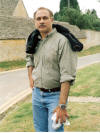|
|
the-south-asian.com July / August 2006 |
|
|||
|
August/September Contents
Sufis - wisdom against 50
years of mountain Heritage cities:
Cotton - the fibre of
|
|
||||
|
Page
2 of 2
TAXILA - 2002 (cntd.) by Salman Minhas
First published in October 2002
Brief History & Background
6th century B.C. Birth of Buddha 563 B.C. Achaemenid or Persian Empire , under King Darius, and later Xerxes .[518 B.C] included Sindh and East Punjab. The language was Aramic and these inscriptions of mid –third century B.C. were found in Sirkup near Taxila. 5th Century B.C. Buddha dies in 483 B.C.
Alexander the great came to Punjab in 326 B.C. At this time Raja Ambi [ Orphis ] was king of Taxila and was at war with the Paurava king Porus whose kingdom was beyond the Jhelum river . Raja Ambi allied himself with Alexander and joined hands with Ora in Swat [ the Udaygram ruins ] and Puskalavati [ today Charsadda near Peshawar] After Alexander’s death in 323 B.C. Gandhara came under the Mauryan Emperors of India .
2nd Century B.C. By 262 B.C. the Mauryan ruler Ashoka the Great, after committing horrific carnage in war, converted to Buddhism. Buddhist Art appears in Taxila and remains up to 800 A.D. Ashoka founded the Dharma Dharmarajika Stupa near Taxila and the Chinese pilgrim Huein Tsang mentions about 1000 monasteries in Gandhara alone. Around 250B.C. Greeks under Menander appear in the Gandhara area. 100 B.C. Central Asian People and tribes called the Scythians and the Parthians in 103 B.C. in Persia and Gandhara ruled the areas at Takhti Bahi [ near Mardan city today .Kushanas were the main dynasty and their king Kanishka printed coins with Buddha’s image. AD 100 Vasudeva was the last Kanishka ruler. The Chinese pilgrim Huein Tsang mentions Purushpura (Peshawar) , and the Ashoka Stupa in Taxila . About 100 images of Buddha were found at Taxila / Gandhara area. In addition Pari- Nirvana stories of the Buddha’s after-death were engraved in stone in Taxila and the coffin, and disposal of his ashes are also recorded. A.D. 300-500 The White Huns, a tribe from Central Asian invade and trample Taxila . Sung Yun a Chinese pilgrim mentions Taxila in AD 520 . A.D. 700 Petty nobles fight for power. The area of Taxila and Gandhara is still Buddhist and priests still follow the " Greater Vehicle" of Buddha’s teachings AD 1100 – 1200 Ghazni kings invade this area. Conversion to Islam begins. Defacing of many sculptures. Invasions into Delhi, India. Babur, the first Mughal also enters the area with his armies _____________
|
|||||
|
Copyright © 2000 - 2006 [the-south-asian.com]. Intellectual Property. All rights reserved. |
|||||

